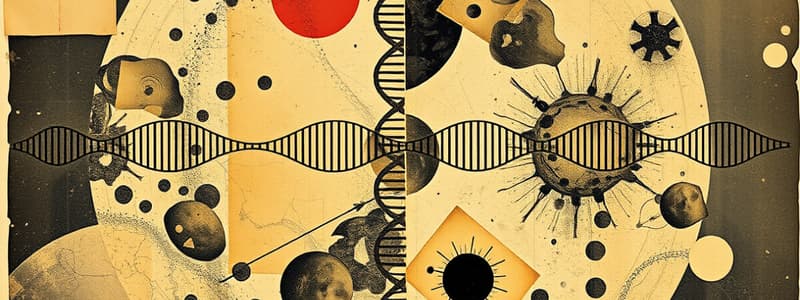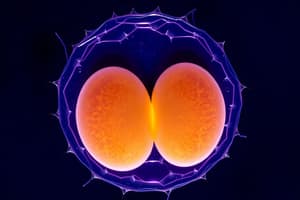Podcast
Questions and Answers
Match each stage of the cell cycle to the corresponding amount of DNA contained within a cell at that stage.
Match each stage of the cell cycle to the corresponding amount of DNA contained within a cell at that stage.
Metaphase II = 7.3 pg Prophase I = 14.6 pg Telophase I before cytokinesis = 14.6 pg After cytokinesis of meiosis II = 3.7 pg G2 = 14.6 pg G1 = 7.3 pg
Select the reasons why meiosis typically produces genetic variation but mitosis does not.
Select the reasons why meiosis typically produces genetic variation but mitosis does not.
- Gametic chromosomes have a different combination of alleles than parental chromosomes as a result of independent assortment. (correct)
- Meiosis produces four genetically different haploid cells. (correct)
- Genetic material is exchanged between homologous chromosomes in meiosis during crossing over. (correct)
- 1n gametes produced in mitosis fuse to produce 2n cells in meiosis.
What fraction in the genome on the pairs of humans would be exactly the same if no crossing over took place? Father and child: _____, Mother and child: _____, Full siblings: _____, Half siblings: _____, Uncle and niece: _____, Grandparent and grandchild: _____
What fraction in the genome on the pairs of humans would be exactly the same if no crossing over took place? Father and child: _____, Mother and child: _____, Full siblings: _____, Half siblings: _____, Uncle and niece: _____, Grandparent and grandchild: _____
Father and child: ½, Mother and child: ½, Full siblings: ½, Half siblings: ¼, Uncle and niece: ¼, Grandparent and grandchild: ¼
How did Mendel use self-pollination and cross-pollination techniques in his experiments with flower color to observe the basic patterns of inheritance?
How did Mendel use self-pollination and cross-pollination techniques in his experiments with flower color to observe the basic patterns of inheritance?
What best explains the results of the geneticists' experiments involving obese mice?
What best explains the results of the geneticists' experiments involving obese mice?
In certain salamanders, when a sex-reversed male is mated with a normal female, what is the sex of the offspring likely to be?
In certain salamanders, when a sex-reversed male is mated with a normal female, what is the sex of the offspring likely to be?
Flashcards are hidden until you start studying
Study Notes
DNA Content in Meiosis Stages
- Metaphase II: 7.3 picograms (pg) of DNA
- Prophase I: 14.6 pg of DNA
- Telophase I Before Cytokinesis: 14.6 pg of DNA
- After Cytokinesis of Meiosis II: 3.7 pg of DNA
- G2 Phase: 14.6 pg of DNA
- G1 Phase: 7.3 pg of DNA
Meiosis vs. Mitosis
- Meiosis typically results in genetic variation due to independent assortment of alleles.
- Crossing over during meiosis allows for genetic material exchange between homologous chromosomes.
- Meiosis produces four genetically distinct haploid cells, whereas mitosis produces identical diploid cells.
Classification of Cells
- Haploid Cells: microspore, first polar body, spermatid, megaspore, ovum, secondary oocyte
- Diploid Cells: primary spermatocyte, microsporocyte, oogonium, spermatogonium
Genetic Relationship Fractions
- Father and Child: ½ shared genetic material
- Mother and Child: ½ shared genetic material
- Full Siblings: ½ shared genetic material
- Half Siblings: ¼ shared genetic material
- Uncle and Niece: ¼ shared genetic material
- Grandparent and Grandchild: ¼ shared genetic material
Mendel's Experiments
- Observed inheritance patterns by cross-pollinating parental plants with different-colored flowers and allowing self-pollination of the F₁ generation to analyze the F₂ generation.
Genetic Cross of Obese Mice
- Obesity in mice results from a recessive allele.
- F₁ mice are normal size; interbreeding produces normal and obese F₂ mice.
- The cross of obese mice from different laboratories produces all normal offspring, indicating the presence of different obesity alleles.
Salamander Sex Determination
- In certain salamanders, females can become functional males (sex-reversed males).
- Breeding these males with normal females results in approximately 2/3 female and 1/3 male offspring.
- Suggests that females are the heterogametic sex in this species.
Studying That Suits You
Use AI to generate personalized quizzes and flashcards to suit your learning preferences.




